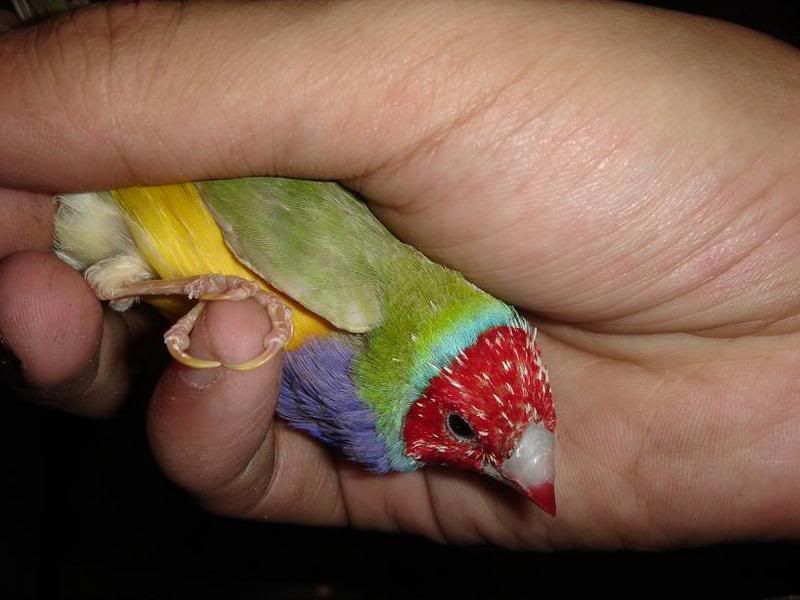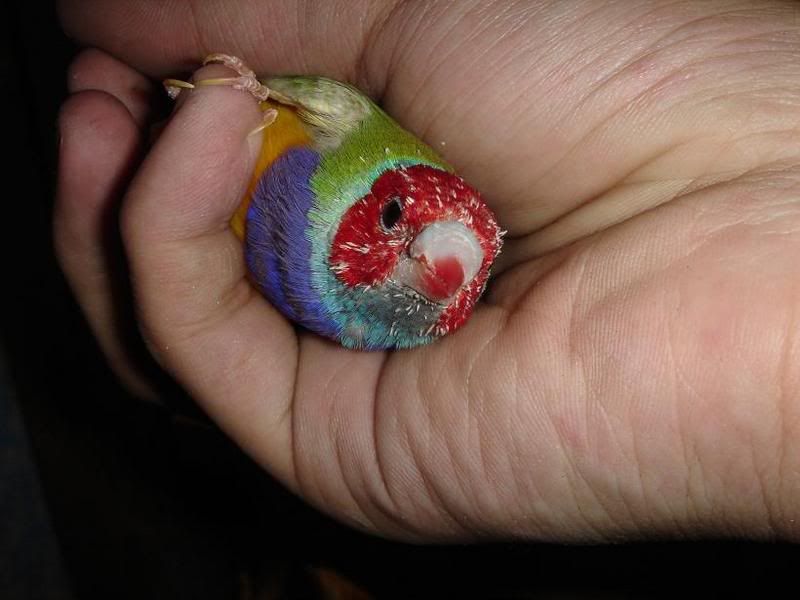For more specific questions related to the many varieties of captive finches.
-
jourdy
- Pip

- Posts: 24
- Joined: Sun Dec 10, 2006 8:49 pm
Post
by jourdy » Thu Feb 15, 2007 5:44 am
-
dreamboat
- Pip

- Posts: 5
- Joined: Sun Jan 14, 2007 8:43 pm
Post
by dreamboat » Thu Feb 15, 2007 6:02 am
Would be helpful to see a picture of the tail..... the cocks have a distinctly longer tail.
Rob
-
jourdy
- Pip

- Posts: 24
- Joined: Sun Dec 10, 2006 8:49 pm
Post
by jourdy » Thu Feb 15, 2007 8:49 am
I'm sorry I don't have pictures of them with tails.
Their tails, however are about the same length.
I think they're about 6 months old. If both are females, I would try to have one replaced by a male.
Seems though that the white breasted one is female as well. No blue collar, and it has a black-ish beak.
-
zookeeper
- Flirty Bird

- Posts: 223
- Joined: Wed Jul 05, 2006 8:16 pm
- Location: West Allis, Wisconsin, USA
-
Contact:
Post
by zookeeper » Thu Feb 15, 2007 8:57 am
I'm thinking the yellow might be a male because of the lighter beak -- but I'm no expert on the color mutations.
-
TammyS
- Callow Courter

- Posts: 186
- Joined: Thu Jun 15, 2006 7:42 am
- Location: Chicago area, IL
-
Contact:
Post
by TammyS » Thu Feb 15, 2007 8:58 am
For WB gouldians, the best way to sex them is by observing them. I usually identify the cocks by singing before anything else as they usually starting to sing around 3 months of age. Other ways to tell are by stature and the tail - although the tail is not always a reliable method.
I would recommend you just observe them for a few days and you should have your answer as to whether or not you have a true pair.
-
kenny
- Weaning

- Posts: 1778
- Joined: Sat Jul 15, 2006 3:45 pm
- Location: East Yorkshire,England
Post
by kenny » Thu Feb 15, 2007 9:51 am
hi jourdy
whatever sex they are the one with the black face needs its beak filing down it is a little to long on the top mandible and it has a overhang on the left hand side it may not bother you in terms of how it looks but if left it will make it eventually impossible for the bird to eat properly.an emery board or nail file will sort it out..dont try to cut it unless you are sure about doing it as you could cut the tongue in doing it
ken
you can always tell a yorkshireman,but you cant tell him much
-
Crystal
- Brooding

- Posts: 1331
- Joined: Sat Feb 11, 2006 2:27 pm
- Location: Richmond, VA
-
Contact:
Post
by Crystal » Thu Feb 15, 2007 11:15 am
They both look like hens to me. I agree that the black headed hen needs her beak gently filed (use a FINE grit emory board, or have your vet do it). The appearance that she has really fits with a nutritional deficiency (especially vitamin A)--although it could be something else; what diet will you have her on?
-
jourdy
- Pip

- Posts: 24
- Joined: Sun Dec 10, 2006 8:49 pm
Post
by jourdy » Thu Feb 15, 2007 12:27 pm
I will try to return the black headed one and exchange it for a male. In the meantime, she's being fed sliced vegetables, spray millet, and various seeds.
What can I do about the vitamin A deficiency?
-
Crystal
- Brooding

- Posts: 1331
- Joined: Sat Feb 11, 2006 2:27 pm
- Location: Richmond, VA
-
Contact:
Post
by Crystal » Thu Feb 15, 2007 7:32 pm
I would definitely add boiled egg crushed shell and all to the diet you are feeding your birds (it contains some vitamin A and a lot of other nutrients)--give this to them at least 3 times per week (daily while breeding or conditioning for breeding), and be sure to remove it from the cage before it spoils (they may only eat a small amount each day and the rest can be frozen/thawed or refrigerated for several days so you won't have as much waste).
I am not sure what vegetables you are feeding, but ones you can provide which are high in vitamin A include: carrots, spinach, parsley, kale, and dandelion.
-
jourdy
- Pip

- Posts: 24
- Joined: Sun Dec 10, 2006 8:49 pm
Post
by jourdy » Sat Feb 17, 2007 7:32 am
Okay so I went to the store, and the guy there said he is positive that the yellow faced one is a male. I asked him how come the purple on its chest is faintly colored, and he said it will become a richer color in the bird's next molt. He told me that if by another month the bird still has dull colors, then I can exchange it back for another one.
Anyway, I decided I couldn't wait that long to get a male one, so I bought this guy:



Excuse my very dirty hand, I just finished cleaning the cage.
It's very hard to find fully molted Gouldians in here.
-
kenny
- Weaning

- Posts: 1778
- Joined: Sat Jul 15, 2006 3:45 pm
- Location: East Yorkshire,England
Post
by kenny » Sat Feb 17, 2007 11:48 am
hi jourdy
that one is in molt also,as you can see the pin feathers coming through..the problem is moving them from one place to another..if one place is warmer or colder than where it has come from it will always go into a moult as they shed thier feathers accordingly...that one looks fit enough ,but it will need its claws trimming otherwise it may get caught up on the wire or the nest fibre
ken
you can always tell a yorkshireman,but you cant tell him much
-
jourdy
- Pip

- Posts: 24
- Joined: Sun Dec 10, 2006 8:49 pm
Post
by jourdy » Sat Feb 17, 2007 8:19 pm
Hi Ken, thanks for the advice. Yeah, I know that he is still molting - I was stating that it's very hard to find fully molted Gouldians for sale in here. Hehe. Anyway, how long does the molt last?
The gouldians are in the flight cage with shaftails, societies, and zebras. I offer them mealworms aside from the seeds, veggies and eggs - but I've never seen the Goulds eat any of the worms. Is too much mealworms bad for the Shaftails? They seem to be the one eating all of it. Haha.
-
tammieb
- Brooding

- Posts: 1241
- Joined: Sat Feb 11, 2006 7:00 pm
- Location: USA/Nebraska
-
Contact:
Post
by tammieb » Sat Feb 17, 2007 8:29 pm
None of my Goulds, Societies, or Shafties eat mealies.
TammieB.
Use the talents you possess - for the woods would be a very silent place if no birds sang except for the best. ~Henry Van Dyke~
-
kenny
- Weaning

- Posts: 1778
- Joined: Sat Jul 15, 2006 3:45 pm
- Location: East Yorkshire,England
Post
by kenny » Sat Feb 17, 2007 8:37 pm
the molt is usually about a month ,when the molt is just seasonal,but that is when the birds stop breeding as they will not do so when they are in molt as it takes far to much out of them...you can shorten the molt by making sure it gets plenty of what it likes the best
ken
you can always tell a yorkshireman,but you cant tell him much
-
jourdy
- Pip

- Posts: 24
- Joined: Sun Dec 10, 2006 8:49 pm
Post
by jourdy » Sat Feb 17, 2007 8:51 pm
Tammieb,
Really? My zebras and shaftails ALWAYS clean up the worm dish before they go to the veggies and seeds dish. Strange.. Maybe I have abnormal shaftails? Hehe.
Kenny,
Thanks so much for the rteply.
Im not planning on breeding them as of now. They are still young (around 6 months). I'm thankful that EVERYONE in the cage goes along really well.





















